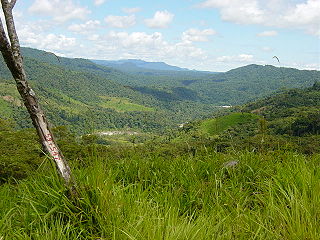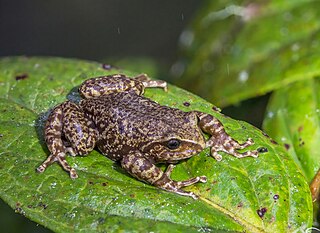
El Cajas National Park or Cajas National Park is a national park in the highlands of Ecuador. It is located about 30 km west from Cuenca, the capital of the province of Azuay. The area of 285.44 km2 between 3100m and 4450m above sea level is characterized by páramo vegetation on a jagged landscape of hills and valleys. It was declared a National Park on November 5, 1996 by resolution N° 057.

Sangay National Park is a national park located in the Morona-Santiago, Chimborazo, Tungurahua, Cañar, and Azuay provinces of Ecuador. The park contains two active volcanoes, one extinct volcano El Altar. Protecting a range of elevations from 900 to 5,319 meters above sea level, Sangay National Park contains a wide variety of habitats, including glaciers, volcanic landscapes, tropical rainforests, cloud forests, wetlands, grasslands, and one of the largest regions of páramo in Ecuador. 327 lakes feed into a vast wetland system covering 31.5 square kilometers (12.2 sq mi).
Pristimantis appendiculatus, the Pinocchio rainfrog, is a species of frog in the family Strabomantidae. It is found on the Pacific slopes of the Andes in Ecuador and extreme southern Colombia.
Pristimantis balionotus is a species of frog in the family Strabomantidae. It is endemic to Ecuador and only known from its type locality on the border between the Loja and Zamora-Chinchipe Provinces, near the crest of the Ecuadorian Andes. Common name crest robber frog has been coined for it.

Pristimantis buckleyi is a species of frog in the family Strabomantidae. It is found on the Andes of Colombia and Ecuador. Specifically, it occurs on the both flanks of the Cordillera Central and on the eastern flank of the Cordillera Occidental in Colombia, and on the Cordillera Real in Ecuador south Cayambe, at elevations of 2,500–3,700 m (8,200–12,100 ft) asl.
Pristimantis cryophilius is a species of frog in the family Strabomantidae. It is endemic to the Ecuadorian Andes in the Azuay, Cañar, and Morona-Santiago Provinces. The specific name cryophilius is derived from Greek kryos for cold and philois for loving and refers to the affinity of this species for cold climate. Common name San Vicente robber frog has been coined for it.
Pristimantis gentryi is a species of frogs in the family Strabomantidae. It is endemic to central Ecuador where it is found in a small area west of the Páramo de Apagua, Cotopaxi Province. The specific name gentryi honors Alwyn Gentry, American botanist who perished during his field work in Ecuador. Common name Pilalo robber frog has been proposed for this species.

Pristimantis katoptroides is a species of frog in the family Strabomantidae. It is found in the eastern slopes of the Andes of Ecuador and Cordillera Central and eastern Andean foothills in northwestern Peru. The specific name katoptroides is Greek for "mirror-like" and refers to the similarity of this species to Pristimantis crucifer, but being found on the other side of the Andes. Common name Puyo robber frog has been proposed for it.
Pristimantis modipeplus is a species of frog in the family Strabomantidae. It is endemic to the Andes of central Ecuador in Chimborazo, Pichincha, and Tungurahua Provinces. Common name Urbina robber frog has been proposed for it.
Pristimantis ocreatus is a species of frog in the family Craugastoridae. Although often reported as being endemic to the Andes of northern Ecuador, it has also been reported from extreme southern Colombia ; the possibility of range extension to Colombia has been acknowledged. Its type locality is the west slope of volcano Chiles in the Carchi Province, and common name Carchi robber frog has been coined for it. These frogs have pale hands and feet, as if wearing gloves and socks—hence the specific name ocreatus, which is Latin and means "wearing leggings" or "booted".
Pristimantis piceus is a species of frog in the family Strabomantidae. It is endemic to Colombia and occurs in the Cordillera Central between the Antioquia Department in the north and the Cauca Department in the south. Many specimens are black in color, and the specific name piceus is Latin meaning "pitch-black".
Pristimantis serendipitus is a species of frog in the family Strabomantidae. It is found in the Andes of northern Peru and adjacent southern Ecuador. The specific name refers to serendipitous discovery of this species: collection at the type locality was only made because the road was closed by an accident. Common name Colan Mountains robber frog has been proposed for this species.
Pristimantis vertebralis is a species of frog in the family Strabomantidae. It is endemic to the Andes of Ecuador and occurs in the Carchi, Imbabura, Pichincha, Cotopaxi, Bolívar, and Azuay provinces. Common name vertebral robber frog has been coined for it.

Pristimantis w-nigrum, also known as the Zurucuchu robber frog or w rainfrog, is a species of frog in the family Strabomantidae. It is found on both Pacific and Amazonian slopes of the Andes in Colombia, Ecuador, and northern Peru. The species is divided to at least eight clades that are genetically highly divergent but morphologically similar; it may be a species complex.
Gastrotheca testudinea is a species of frog in the family Hemiphractidae. It has a widespread latitudinal range along the eastern (Amazonian) slopes of the Andes of Ecuador, Peru, and Bolivia.
Telmatobius niger is a species of frog in the family Telmatobiidae. It is endemic to the Andes of Ecuador, with records from both Amazonian and Pacific versants. Last seen in 1994, it is feared that this species may be extinct. Common name black water frog has been coined for it.

Pristimantis is a very large genus of frogs distributed in the southern Caribbean islands and in Central and South America from Honduras to northern Argentina and southern Brazil. With 596 described species, the genus had more species than any other genus of vertebrate animals. Many of these species genus are endemic to the Northwestern Andean montane forests ecoregion in north-western South America.

Pristimantis ashaninka is a species of frog in the Craugastoridae family. It is found in the Pui Pui Protection Forest in central Peru. It is 23 to 26 millimeters long, and is characterized by containing small conical tubercles in its skin, giving a spiny appearance, and by having no tympanic membrane. The species was described in 2017 after morphological and genetic analyses and was named Pristimantis ashaninka in honor of the indigenous people Asháninka, who live in the regions near the protection forest. The species was listed by the International Union for Conservation of Nature as a least-concern species. There is still no information about its behavior and/or reproduction, but it is assumed that the tadpoles have direct development, as this is a common characteristic of the genus.

Rhinella lilyrodriguezae is a species of frog in the family Bufonidae, which is found in Cordillera Azul National Park in Peru.









